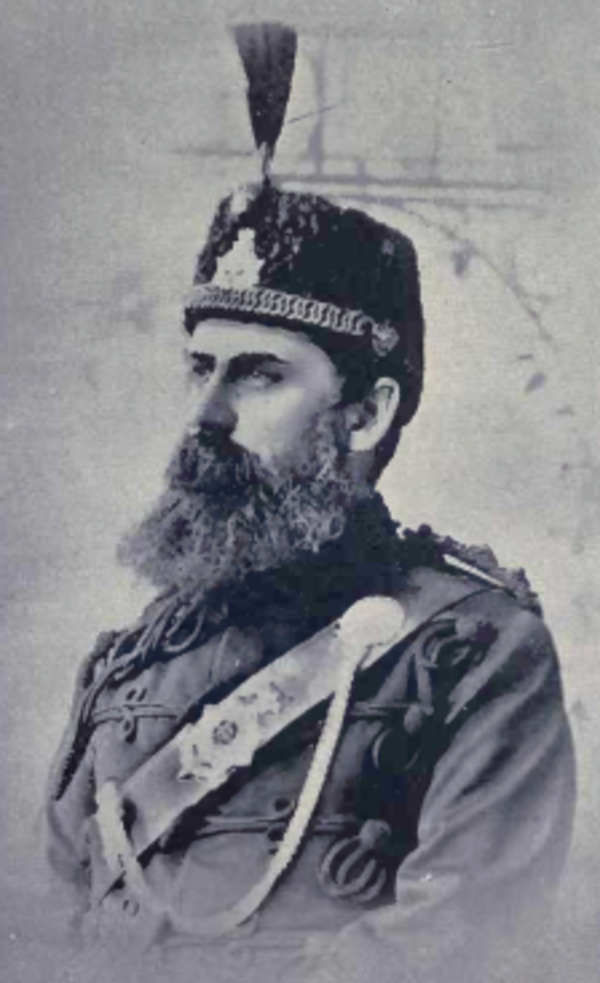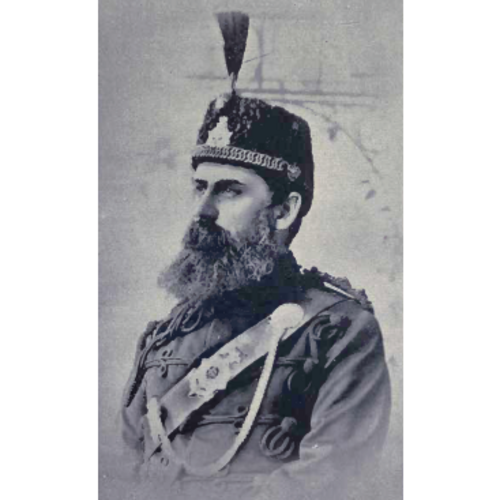
Source: Courtesy of Wikimedia Commons
KENNEDY, WILLIAM NASSAU, house painter, soldier, politician, civic official, and entrepreneur; b. 28 April 1839 at Newcastle, Upper Canada, second of six children of John Kennedy, a lieutenant-colonel in the militia, and Catharine Lambert; m. Mary Anne Chambers, and they had four sons and one daughter; d. 3 May 1885 in London, England.
William Nassau Kennedy left school at an early age and worked as a contractor for a brief period. He then trained for two years with David William Dumble, a barrister at Peterborough, but subsequently took up his father’s occupation of house painter and interior decorator. The Kennedy family had a distinguished military tradition; in February 1857 William enlisted as a private in the newly organized 1st Company, Peterborough Rifles. With his father and brothers he took part in the formation of the 1st Company, Peterborough Infantry, five years later. After progressing through several non-commissioned ranks, Kennedy earned a 1st class certificate from the Toronto Military School and was commissioned ensign on 7 July 1865. The new subaltern accompanied his father’s unit for the defence of the Niagara peninsula during the Fenian invasion of June 1866 but the Peterborough volunteers never saw action. The next year Kennedy was gazetted temporary adjutant and drill instructor as captain of the newly formed 57th (Peterborough) Battalion of Infantry. Subsequently he obtained a 1st class certificate from the Military Riding School in Toronto, rating special mention for proficiency in horsemanship and swordsmanship. Like his father, who had been a justice of the peace and an assessor for Peterborough, William was public spirited, and served on the Peterborough Town Council for six years.
Late in 1869 came the news that the Métis at the Red River Settlement (Man.) were offering armed resistance to the annexation of Rupert’s Land by Canada. To Captain Kennedy went the coveted vacancy allotted to the 57th Battalion for one officer on the Red River expedition dispatched west under the command of Colonel Garnet Joseph Wolseley*. Kennedy journeyed to Upper Fort Garry (Winnipeg) as a lieutenant in the 1st Battalion of Infantry (Ontario Rifles), gaining experience and the warm friendship of Colonel Wolseley, a bond which later would prove beneficial to him.
Kennedy elected to stay in Manitoba, and when in October 1871 a Fenian raid led by William Bernard O’Donoghue* and John O’Neill* was launched into Manitoba from adjacent American territory, he raised a temporary volunteer unit, the Winnipeg Rifle Company, to help the small Winnipeg garrison repel the invaders. The event stressed the value of maintaining a local force of citizen-soldiers, and exactly one week after the invasion Kennedy helped to found the Winnipeg Field Battery of which he became adjutant. The following year he rose to command the unit, an appointment he was to hold until 1883.
In the 1870s Kennedy became a leading citizen of Winnipeg. He was made registrar of deeds for Selkirk County and Winnipeg and city clerk in 1873, posts which it is believed he held as late as 1881. In 1874 he became a member of the first Executive Council of the North-West Territories and in 1875 was elected the second mayor of Winnipeg. He held the former office for one year and the latter for two consecutive one-year terms. His family eventually joined him in Winnipeg in 1876. He was a member of the Protestant section of the Board of Education of Manitoba from 1876 until at least 1881, serving as chairman in 1876.
As a prominent booster of Manitoba, Kennedy was active in some 11 railway charter groups between 1875 and 1883, was involved in the affairs of the Manitoba South-Western Colonization Railway, and was vice-president of the Manitoba and Hudson’s Bay Railway in 1884. He also seems to have dealt in real estate. His inclination toward community life led him to join the Orange order, the Foresters, and many other fraternal organizations. A charter member of the Prince Rupert’s Lodge, Kennedy became deputy grand master in the freemasons’ Grand Lodge of Manitoba when it was formed in 1875. His other interests ranged from competition rifle shooting to music.
The west in 1883 was troubled by economic difficulties, labour disputes in the construction crews of the Canadian Pacific Railway, and unrest among the Métis and Indians who felt threatened by the advancing railway. The North-West Mounted Police were too few and the militia corps on the prairies not well enough trained and equipped to handle any widespread disturbances. An apprehensive group of Winnipeggers led by Captain Kennedy resolved to raise a full battalion of rifles. On 9 Nov. 1883 the 90th Winnipeg Rifles was organized. Kennedy was chosen to command and was accordingly promoted to major and brevet lieutenant-colonel.
In the midst of organizing his battalion, Colonel Kennedy learned that his old commander and colleague, now Major-General Sir Garnet Joseph Wolseley, was seeking Canadian boatmen to transport a British military expedition up the Nile River into the Sudan to rescue Major-General Charles George Gordon trapped in Khartoum. Kennedy swiftly raised a contingent from Manitoba, but his personal offer to go was refused by British recruiting authorities. Major Frederick Charles Denison*, of the influential Toronto military family and commander of the Canadian voyageurs, did not relish taking as his subordinate an officer senior to himself. The Manitoba volunteers, on the other hand, exhibited such displeasure at the prospect of proceeding overseas without Kennedy that the impasse was avoided by promoting Denison to brevet lieutenant-colonel and allowing Kennedy to go to Egypt in the civilian capacity of foreman. Once there, Denison recruited Kennedy to act as temporary paymaster to the Canadian contingent, whereupon the latter exploited his old friendship with General Wolseley in the interest of having himself appointed permanent paymaster.
Apart from his professional qualifications, Kennedy proved himself on more than one occasion among the ablest manipulators in the patronage-ridden militia of the time. When recruiting for the voyageur contingent, Kennedy, quite against explicit instructions from the British authorities to hire only experienced men, included some of Winnipeg’s young business and professional élite. These youthful imperialists were genuinely imbued with a spirit of adventure and patriotism, but knew next to nothing about the handling of boats. Kennedy accompanied the voyageurs throughout the journey up the Nile, taking every opportunity to favour his Manitobans in the face of Denison’s criticism of their questionable performance as boatmen. On the return voyage to England, he contracted smallpox and was hospitalized in London where he finally succumbed to the disease.
William Nassau Kennedy was a characteristic 19th-century Canadian civic leader, entrepreneur, and militia commander. In a competitive frontier environment where opportunities abounded for the enterprising, most men found little in the militia establishment to attract them. Some, like Kennedy, imbued with an intense patriotism for Canada and the empire, were not above manipulating men and circumstances, or employing patronage and the privileges of office, in the interests of keeping up a force of citizen soldiers as a symbol of order and authority – a force which would be tested in the North-West rebellion of 1885.
PAM, MG 14, B59. Records of the Nile voyageurs, 1884–85: the Canadian voyageur contingent in the Gordon relief expedition, ed. C. P. Stacey (Toronto, 1959). George Young, Manitoba memories; leaves from my life in the prairie province, 1868–1884 (Toronto, 1897). Manitoba Daily Free Press, 4 May, 24 Oct. 1885. Peterborough Examiner (Peterborough, Ont.), 7 May 1885. E. J. Chambers, The 90th Regiment: a regimental history of the 90th Regiment, Winnipeg Rifles ([Winnipeg], 1906). Roy MacLaren, Canadians on the Nile, 1882–1898: being the adventures of the voyageurs on the Khartoum relief expedition and other exploits (Vancouver, 1978).
Cite This Article
J. A. Rodger Letourneau, “KENNEDY, WILLIAM NASSAU,” in Dictionary of Canadian Biography, vol. 11, University of Toronto/Université Laval, 2003–, accessed September 4, 2024, https://www.biographi.ca/en/bio/kennedy_william_nassau_11E.html.
The citation above shows the format for footnotes and endnotes according to the Chicago manual of style (16th edition). Information to be used in other citation formats:
| Permalink: | https://www.biographi.ca/en/bio/kennedy_william_nassau_11E.html |
| Author of Article: | J. A. Rodger Letourneau |
| Title of Article: | KENNEDY, WILLIAM NASSAU |
| Publication Name: | Dictionary of Canadian Biography, vol. 11 |
| Publisher: | University of Toronto/Université Laval |
| Year of publication: | 1982 |
| Year of revision: | 1982 |
| Access Date: | September 4, 2024 |



